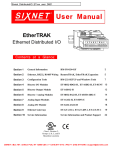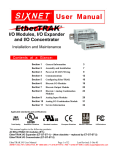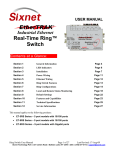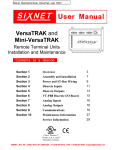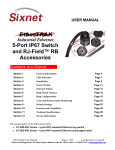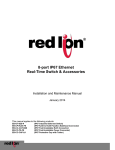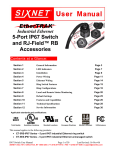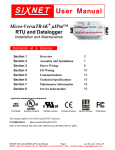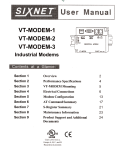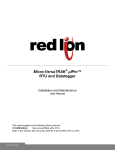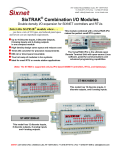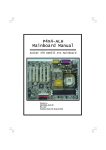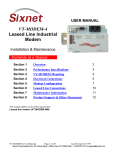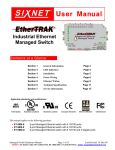Download RemoteTRAK
Transcript
Sixnet_DistributedIO_RD485_user_D301 RemoteTRAK RS485 Distributed I/O for Modbus and SIXNET Systems Contents at a Glance: Section 1 General Information RM-PS-024-01F 3 Section 2 RS485 Wiring RM-232-485-4U 5 Section 3 Configuration Tools RM-232-SETUP and Windows Tools 7 Section 4 Discrete Input Modules RM-8DI2-F, -U and RM-16DI2-H 8 Section 5 Discrete Output Modules RM-8DO2-F and RM-16DO2-H 11 Section 6 Analog Input Modules RM-8AI2-F, RM-16AI2-H, RM-8INS 13 Section 7 Analog Output Modules RM-8AO2-F and RM-4AO2-F 16 Section 8 Combination I/O Modules RM-4DI2-4DO2-U and RM-4DI2-4AI2-U 17 Section 9 Service Information Service Information and Product Support 19 Class I, Division 2, Groups A, B, C, and D Hazardous Locations SIXNET • Box 767 • Clifton Park, NY 12065 USA • +1 (518) 877-5173 • FAX +1 (518) 877-8346 • [email protected] PROTECTED TECHNOLOGY POLICY SIXNET protects your investment in SIXNET systems with long-term planned technology and our unique Protected Technology Policy. We will continue to support the specified capabilities of standard SIXNET products for at least five years. We plan each product improvement and new feature to be upward compatible with existing designs and installations. Our goals are to make each new software release bring new power to your SIXNET systems and have every existing feature, applications program and data file continue to work. We protect your investment even further with a liberal five-year trade-in policy. Exchange standard products for upgraded versions of the same product to take advantage of new features and performance improvements at any time for five years. A prorated trade-in allowance will be given for your existing equipment. SIXNET protects your long-term productivity with state-of-the-art planned technology and continued support. STATEMENT OF LIMITED WARRANTY SIXNET, manufacturer of SIXTRAK, VersaTRAK, RemoteTRAK and EtherTRAK products, warrants to Buyer that products manufactured by SIXNET will be free from defects in material and workmanship. SIXNET’s obligation under this warranty will be limited to repairing or replacing, at SIXNET’s option, the defective parts within 1 year of the date of installation, or within 18 months of the date of shipment from the point of manufacture, whichever is sooner. Products may be returned by Buyer only after permission has been obtained from SIXNET. Buyer will prepay all freight charges to return any products to the repair facility designated by SIXNET. This limited warranty does not cover losses or damages that occur in shipment to or from Buyer or due to improper installation, maintenance, misuse, neglect or any cause other than ordinary commercial or industrial applications, This limited warranty is in lieu of all other warranties whether oral or written, expressed or implied. SIXNET’s liability shall not exceed the price of the individual unit which is the basis of the claim. In no event shall SIXNET be liable for any loss of profits, loss of use of facilities or equipment or other indirect, incidental or consequential damages. INSTALLATION AND HAZARDOUS AREA WARNINGS These products should not be used to replace proper safety interlocking. No software-based device (or any other solid-state device) should ever be designed to be responsible for the maintenance of consequential equipment or personnel safety. In particular, SIXNET disclaims any responsibility for damages, either direct or consequential, that result from the use of this equipment in any application. All power, input and output (I/O) wiring must be in accordance with Class I, Division 2 wiring methods and in accordance with the authority having jurisdiction. WARNING – EXPLOSION HAZARD – SUBSTITUTION OF COMPONENTS MAY IMPAIR SUITABILITY FOR CLASS 1, DIVISION 2. WARNING – EXPLOSION HAZARD – WHEN IN HAZARDOUS LOCATIONS, DISCONNECT POWER BEFORE REPLACING OR WIRING MODULES. WARNING – EXPLOSION HAZARD – DO NOT DISCONNECT EQUIPMENT UNLESS POWER HAS BEEN SWITCHED OFF OR THE AREA IS KNOWN TO BE NONHAZARDOUS. Note: All information in this document applies to RemoteTRAK I/O, except where otherwise noted. Refer to the SIXNET I/O Tool Kit software online help system for detailed product specifications and configuration settings. RemoteTRAK User Manual Page 2 Last Revision: March 2001 RemoteTRAK manual.doc Section 1 General Information Overview This manual will help you install and maintain RemoteTRAK I/O. In summary, wiring for power, communications and I/O is connected to each module’s base. Then, setup choices are entered using the SIXNET I/O Tool Kit software and the system is ready to run. Performance Specifications These general specifications apply to all RemoteTRAK modules. Supply Voltage Modules per RS485 bus RS485 Isolation Operating Temperature Storage Temperature Humidity Power Wiring 9 - 30 VDC, 0.5 Watt typical per module (25 mA @ 24 VDC – varies by module and load). 32 (use a RM-232-485-4U to drive a total of 128 modules) 1200 Volts RMS (for 1 minute) -30 to 70 °C -40 to 85 °C 5 to 95% (non-condensing) RemoteTRAK modules can be powered from the same DC source that is used to power your I/O devices. No separate power supply is required. 10 to 30 VDC needs to be applied to terminals 17 and 18 on the base of each module. Some RemoteTRAK modules distribute power or return connections to I/O terminals for your convenience in making field-wiring connections. Refer to the wiring diagram for each module for more information. The RM-PS-024-01F can be used to power your RemoteTRAK modules, instrumentation loops, and other devices. It operates on 85264 VAC (47-63 Hz) or 120-370 VDC and outputs 24 VDC at up to 1 A. Refer to the figure below for the proper power connections. Tighten the screw terminals to a maximum of 3.48 in-lbs. Section 1 General Information 3 Status LED Indication On, with a quick “OFF” BLINK (1.9 seconds ON, .1 seconds OFF) - The module is configured and fully operational, but has not received a valid request from the host for a time longer than the specified time out period. A communication time out has occurred. Full ON - The module is configured, fully operational, and has received communication from the host device before the timeout period expired. This is the desired LED indication during system operation. HALF BLINK (1 second ON, 1 second OFF) - The module is not adequately configured and requires a download from the SIXNET I/O Tool Kit utility. Full OFF - There is no power to the module, or the status LED is being turned off intentionally by SIXNET I/O Tool Kit during the module loading operation. Off, with a quick “ON” BLINK (1.9 seconds OFF, .1 seconds ON ) - The module failed self-test at initialization. It will not attempt communication and should be replaced. Status LED Wink Feature Section 1 The “Status” LED may be intentionally winked (10 blinks/ second) by the SIXNET I/O Tool Kit utility to visually identify the module when other modules are present. General Information 4 Section 2 RS485 Wiring Guidelines RS485 Wiring RemoteTRAK modules communicate with a master controller (PC, SIXTRAK Gateway, VersaTRAK, DCS, PLC, etc.) using a two wire RS485 party-line. It is recommended that in addition to the two signal wires, a shield or ground wire be connected to reference all stations to a common return. The RS485 port on all RemoteTRAK modules is isolated from its internal circuitry, local power source, and I/O wiring to improve communications reliability. It is recommended that only 32 RemoteTRAK modules be connected on an unbuffered RS485 partyline, and that the termination jumper be installed on the last module on the end of a network segment. Limiting the cabling to two network arms (segments) radiating from the master controller will yield best signal results. RM-232-485-4U RS232 to RS485 Four Port Converter Overview This interface provides a convenient way to connect RS485 bussed RemoteTRAK I/O modules to a RS232 port on a master controller. Designed specifically for driving RemoteTRAK modules, this converter is fully automatic, requiring no user settings. Four RS485 ports are provided to allow up to 128 I/O modules to be connected in a star configuration (multiple network arms). Electrical isolation is provided between the RS232 and RS485 ports for increased reliability. This RS232 to RS485 converter is recommended when: RemoteTRAK I/O modules need to be connected to an RS232 port on the master controller. More than 32 RemoteTRAK modules and/or other RS485 devices are to be addressed. A “star” wiring configuration (more than two network wiring segments) is needed. Electrical isolation between the RS485 party-line and the RS232 port on the master controller will increase reliability. 1. 2. 3. 4. RS232 Wiring Only the transmit (TD), receive (RD) and common return (GND) signals need be connected in the RS232 cable. A SIXNET ST-CABLE-PF or other suitable null modem cable may be connected to the DB9 connector in the face of the module. Alternatively, signals may be connected to the wiring base as shown in the upcoming diagram. The RM-232-485-4 module detects message direction and automatically generates a transmitter enable (keying) signal. The DTR signal is always high (asserted) to provide a pull up for any lines in the master controller that may need to be tied off. RS485 Wiring All four RS485 ports are interchangeable and may each drive up to 32 RemoteTRAK modules. In addition to the two wire signal pair, it is recommended that a shield or third ground conductor be connected to the RS485 ground terminal to reference all stations together. All four RS485 ports are referenced to the same internal signal common (ground), which is electrically isolated from the RS232 port and DC power input terminals. It is recommended that a jumper wire be connected between the “RS485(-)” terminal and “Term” terminal if this device is on the end of a network arm (i.e. it is the last station on the RS485 bus). Screw Torque All the screw terminals on the base should be tightened to a maximum of 3.48 in-lbs. Section 2 RS485 Wiring 5 Section 2 RS485 Wiring 6 Section 3 Configuration Tools RM-232-SETUP Portable Remote I/O Field Configuration Tool Operation This setup tool is the most convenient way to configure a RemoteTRAK I/O module. Unplug any module and insert this setup tool in its place. Commands from the SIXNET I/O Tool Kit software in your Windows-based PC store the configuration information into permanent memory in the module’s base. This module automatically reads the unique serial number stored in the base, making it unnecessary for you to enter the serial number into the software manually. Upon reinsertion, the I/O module finds this configuration information, instantly configures itself and begins to scan I/O. It is permissible to configure RemoteTRAK modules in live systems using this setup tool. Note: RemoteTRAK “smart bases” allow hot swap of live modules -- an exclusive SIXNET feature. Wiring Connect this module to your Windows PC using a standard SIXNET ST-CABLE-PF RS232 cable. Only the transmit (TD), receive (RD) and common return (GND) signals are actively used. The RS232 port on this configuration tool is electrically isolated to protect your computer in the event of field wiring errors. This module requires DC supply power on terminals 17 and 18 on the wiring base it is plugged into. No other connections are required. (I/O wiring will be left undisturbed.) RS232 Mode This module always communicates to the host PC at 9600 baud, with no parity and eight data bits. Be sure to set the communications port on your computer to these default settings. Alternative Setup Method RemoteTRAK modules may also be configured by connecting the RS485 party-line to an RS485 port or RS232 port (through a converter) on your PC. It will be necessary to enter the serial number found on each module’s base in the SIXNET I/O Tool Kit to enable this setup software to initially talk to each module. In most situations, setup through the RS485 port can only be done with the system off-line. Use a RM-232-SETUP module for on-line setup changes. (See above.) SIXNET I/O Tool Kit All configuration parameters are entered using the SIXNET I/O Tool Kit Windows software, which stores all setup information into permanent memory in each module’s wiring base. No field jumpers or DIP switches are required on RemoteTRAK module (except wiring jumpers in the base of some 4 - 20 mA input modules). Section 3 Configuration Tools 7 Section 4 Discrete Input Modules RM-8DI2-F RM-8DI2-U Overview 8 Discrete Inputs / Counters with Direct Field Wiring Base 8 Discrete Inputs / Counters with Isolated Inputs The popular field wired (-F) base provides a pre-wired connection to DC power for each of the eight discrete input channels. For applications which require individually isolated, ground sinking, or AC inputs, the universal wiring (-U) base is recommended. An input count feature uses analog input registers to accumulate the positive transitions of each input. More information on this and other features can be found in the on-line help supplied with the SIXNET I/O Tool Kit. Number of Channels Input Voltage Range Maximum Count Rate 8 discrete inputs with pulse counter feature 10 - 30 VDC (-F base), 10 - 30 VDC/VAC (-U base) 100 Hz (6000 / minute) each input, plus selectable 2KHz (120,000 / minute) mode for input 1 only -F Wiring The even numbered terminals (2 - 16) on this field wiring ready base are pre-wired to the DC power (+) terminal. Adjacent pairs of terminals are connected to each input (switch) device. -U Wiring A pair of floating terminals is provided for each input to provide channel-to-channel isolation (floating inputs) and a choice of sourcing (power switching), sinking (ground switching) or AC signals on each input. I/O Registers Function Discrete Inputs Counter Inputs Section 4 SIXNET Registers X0 - X7 AX0 - AX7 Discrete Input Modules Modbus Registers 10001 – 10008 30001 - 30008 Unsigned values: 0 8 Å 65,535 Section 4 Discrete Input Modules 9 RM-16DI2-H Overview High Density Discrete Input Module Sixteen discrete inputs accept DC sourcing signals that are all tied to a common return. More information can be found in the on-line help supplied with the SIXNET I/O Tool Kit. Number of Channels Input Voltage Range Input Current @ 12 VDC Input Current @ 24 VDC 16 discrete inputs (connected to a common DC source) 10 - 30 VDC 3.5 mA 7.0 mA -H Wiring This high density input module provides a single terminal input for each channel. Positive DC voltage must be applied to an input to indicate an ON condition. All channels are referenced to a common return which is connected to the negative side (ground) of the DC power source. I/O Registers Function Discrete Inputs Section 4 SIXNET Registers X0 - X15 Discrete Input Modules Modbus Registers 10001 – 10016 10 Section 5 Discrete Output Modules RM-8DO2-F Overview 8 Channel High Output Current Module Eight discrete output channels provide up to 3 Amps DC to motor contactors, valves, and other loads. Overload and thermal shutdown protection are provided. Each of the eight outputs may optionally be configured as Time Proportioned Outputs that pulse ON at a duty cycle proportional to an analog output register value. Typically these TPO outputs are controlled by a PID loop or other process algorithm in a control program. More information may be found in the on-line help supplied with the SIXNET I/O Tool Kit. Number of Channels Output Voltage Range Max. Load per Output Max. Load per Module Max. Inrush Current 8 discrete outputs connected to a common DC source 10 - 30 VDC 3 Amps 10 Amps 10 Amps (for 100 mS) -F Wiring Two terminals, including a ground return, are provided for each output channel. All channels are powered by a common DC source which is connected to the DC power input terminal. I/O Registers Function Discrete Outputs TPO Values TPO Feature Section 5 SIXNET Registers Y0 - Y7 AY0 - AY7 Modbus Registers 00001 - 00008 40001 - 40008 0 to 100% ON: 0 Å 32767 Time proportioned outputs pulse ON and OFF with a duty cycle proportional to an analog value stored in an analog output register. TPO outputs are a low cost way to get smooth proportional control of heaters and other process variables. Typically, TPO analog output registers are assigned to the output of PID or other control logic in an ISaGRAF or other program. Use the SIXNET I/O Tool Kit to set pulse cycling as fast as 10 mS or as slow (many minutes) as your system dynamics require. Each output may be individually configured as a TPO or ordinary discrete output. Discrete Output Modules 11 RM-16DO2-H Overview High Density Discrete Output Module Sixteen discrete outputs provide power for loads up to 1 Amp. This module does not provide over current protection or TPO capabilities. More information can be found in the on-line help supplied with the SIXNET I/O Tool Kit. Number of Channels Output Voltage Range Max. Load per Output Max. Load per Module Max. Inrush Current 16 discrete outputs connected to a common DC source 10 - 30 VDC 1 Amp 10 Amps 5 Amps (for 100 mS) -H Wiring A single terminal is provided for each output channel. All outputs are powered from the DC power terminal. All channels are referenced to a common return which is connected to the negative side (ground) of the DC power source. I/O Registers Function Discrete Outputs Section 5 SIXNET Registers Y0 - Y15 Discrete Output Modules Modbus Registers 00001 - 00016 12 Section 6 Analog Input Modules RM-8AI2-F Overview 8 Channel 4-20 mA Analog Inputs Eight 4-20 mA inputs provide 16 bit high resolution analog measurements. Each input circuit in this module provides a field selectable choice of providing DC power (for loop powered transmitters) or accepting a ground return (from internally powered instruments). More information can be found in the on-line help supplied with the SIXNET I/O Tool Kit. Number of Channels Input Range Input Impedance 8 (16 bit resolution) 4 - 20 mA 100 ohms Note: input voltage drop = 2 volts at 20 mA -F Wiring Two terminals are provided for each input channel. Either DC power or ground may be provided for each input device by setting a jumper inside the base. (Access these jumpers by unplugging the module and then opening the hinged door in the wiring base.) Refer to the diagram below. Please be sure to provide a suitable instrumentation ground to avoid measurement errors due to ground loops. Current Shunts Precision 100 ohm current shunts, beneath the hinged access door in the wiring base, pass current and maintain loop integrity even if the module is unplugged. A spare shunt is provided and may be simply inserted in place of any socketed shunt that open circuits as a result of a current overload. I/O Registers Function Analog Inputs Section 6 SIXNET Registers AX0 - AX7 Analog Input Modules Modbus Registers 30001 - 30008 Bipolar values: -32768 13 Å 32767 RM-16AI2-H Overview High Density 4-20 mA Analog Input Module Sixteen 4-20 mA inputs provide 16 bit high resolution analog measurements. More information can be found in the on-line help supplied with the SIXNET I/O Tool Kit. Number of Channels Input Range Input Impedance 16 (16 bit resolution) 4 - 20 mA 100 ohms Note: input voltage drop = 2 volts at 20 mA -H Wiring A single input terminal is provided for each measurement channel. Care must be taken to externally provide a suitable instrumentation ground for these single ended input circuits. Current Shunts Precision 100 ohm current shunts, beneath the hinged access door in the wiring base, pass current and maintain loop integrity even if the module is unplugged. A spare shunt is provided and may be simply inserted in place of any socketed shunt that open circuits as a result of a current overload. I/O Registers Function Analog Inputs Section 6 SIXNET Registers AX0 - AX15 Analog Input Modules Modbus Registers 30001 - 30016 Bipolar values: -32768 14 Å 32767 RM-8INS-U Overview Instrumentation Analog Input Module Eight isolated input channels provide 16 bit high resolution analog measurements. More information can be found in the on-line help supplied with the SIXNET I/O Tool Kit. Number of Channels 8 (16 bit resolution) Input Ranges JKERTBCNS Thermocouples, 62 mV to 10V, 4 - 20 mA Input Impedance (4-20 mA) 100 ohms Note: input voltage drop = 2 volts at 20 mA Input Impedance (other ranges) 200K Ohms -U Wiring Two input terminals are provided for each measurement channel. Channel to channel isolation is provided. Current Shunts Precision 100 ohm current shunts, beneath the hinged access door in the wiring base, pass current and maintain loop integrity even if the module is unplugged. A spare shunt is provided and may be simply inserted in place of any socketed shunt that open circuits as a result of a current overload. I/O Registers Function Analog Inputs Section 6 SIXNET Registers AX0 – AX7 Analog Input Modules Modbus Registers 30001 – 30008 Bipolar values: -32768 15 Å 32767 Section 7 Analog Output Modules RM-8AO2-F RM-4AO2-F Overview 8 Channel 4-20 mA Analog Output Module 4 Channel 4-20 mA Analog Output Module These analog output modules provide 4-20 mA signals as proportional control for process signals or to drive chart recorders or other measurement devices. More information may be found in the on-line help supplied with the SIXNET I/O Tool Kit. Number of Channels Output Range Load Resistance Range -F Wiring Two terminals are provided for each output channel. Outputs are directly powered from the DC power connected to this module. Note: I/O Registers 4 or 8 (13 bit resolution -- 0.03% of full scale) 4 - 20 mA 0 - 750 ohms (at a supply voltage of 24 VDC) Both modules use a RM-8AO2-FB wiring base. Only the first four channels are used on the RM-4AO2-F. System capacity may be increased by plugging a RM-8AO2-M eight channel module into a base previously occupied by a RM-4AO2-M four channel module. Function Analog Outputs SIXNET Registers AY0 - AY7 Modbus Registers 40001 - 40008 Positive values: 0 Note: Only the first four registers are used on the RM-4AO2-F. Section 6 Analog Input Modules 16 Å 32767 Section 8 Combination I/O Modules RM-4DI2-4DO2-U Overview Combined Discrete Input and Output Module This module combines four discrete inputs and four discrete outputs. An input count feature uses analog input registers to accumulate the positive transitions of each input. Each of the four outputs may optionally be configured as Time Proportioned Outputs that pulse ON at a duty cycle proportional to an analog output register value. More information can be found in the on-line help supplied with the SIXNET I/O Tool Kit. Number of Discrete Inputs Input Voltage Range Number of Discrete Outputs Max. Load per Output Max. Inrush Current 4 10 - 30 VDC/VAC 4 1 Amp 5 Amps (for 100 mS) -U Wiring A pair of floating terminals is provided for each input to provide channel-to-channel isolation and a choice of sourcing (power switching), sinking (ground switching) or AC signals on each input. The outputs all switch power from the DC power input terminal. A ground return for each output is provided for your convenience. I/O Registers Function Discrete Inputs Discrete Outputs Counter Inputs TPO Values Section 8 SIXNET Registers X0 - X3 Y0 - Y3 AX0 - AX3 AY0 - AY3 Combination I/O Modules Modbus Registers 10001 – 10004 00001 – 00004 30001 - 30004 Unsigned values: 0 40001 - 40004 0 to 100% ON: 0 Å 65,535 Å 32767 17 RM-4DI2-4AI2-U Overview Combined Discrete Input and Analog Input Module This module combines four discrete inputs and four analog inputs. A discrete input count feature uses analog input registers to accumulate the positive transitions of each input. The four analog inputs accepts signals from internally powered or loop powered devices. More information can be found in the on-line help of the SIXNET I/O Tool Kit. Number of Discrete Inputs Input Voltage Range Number of Analog Inputs Input Range Input Impedance 4 10 - 30 VDC 4 4 - 20 mA 100 ohms Note: input voltage drop = 2 volts at 20 mA -U Wiring A pair of floating terminals is provided for each discrete input to provide channel-to-channel isolation and a choice of sourcing (power switching), sinking (ground switching) or AC signals on each input. Two terminals are provided for each analog input channel. Either DC power or ground may be provided for each input device by setting a jumper inside the base. (Access these jumpers by unplugging the module and then opening the hinged door in the wiring base.) Refer to the diagram below. Please be sure to provide a suitable instrumentation ground to avoid measurement errors due to ground loops. Current Shunts Precision 100 ohm current shunts, beneath the hinged access door in the wiring base, pass current and maintain loop integrity for each of the four analog input channels even if the module is unplugged. A spare shunt is provided and may be simply inserted in place of any socketed shunt that open circuits as a result of a current overload. I/O Registers Function Discrete Inputs Analog Inputs Counter Inputs Section 8 SIXNET Registers X0 - X3 AX0 - AX3 AX4 - AX7 Combination I/O Modules Modbus Registers 10001 - 10004 30001 - 30004 Bipolar values: -32768 32767 65,535 30005 - 30008 Unsigned values: 0 Å 18 Å Section 9 Service Information Service Information We sincerely hope that you never experience a problem with any SIXNET product. If you do need service, call SIXNET at (518) 877-5173 and ask for Applications Engineering. A trained specialist will help you to quickly determine the source of the problem. Many problems are easily resolved with a single phone call. If it is necessary to return a unit to us, an RMA (Return Material Authorization) number will be given to you. SIXNET tracks the flow of returned material with our RMA system to ensure speedy service. You must include this RMA number on the outside of the box so that your return can be processed immediately. The applications engineer you are speaking with will fill out an RMA request for you. If the unit has a serial number, we will not need detailed financial information. Otherwise, be sure to have your original purchase order number and date purchased available. We suggest that you give us a repair purchase order number in case the repair is not covered under our warranty. You will not be billed if the repair is covered under warranty. Please supply us with as many details about the problem as you can. The information you supply will be written on the RMA form and supplied to the repair department before your unit arrives. This helps us to provide you with the best service, in the fastest manner. Normally, repairs are completed in two days. Sometimes difficult problems take a little longer to solve. If you need a quicker turnaround, ship the unit to us by air freight. We give priority service to equipment that arrives by overnight delivery. Many repairs received by mid-morning (typical overnight delivery) can be finished the same day and returned immediately. We apologize for any inconvenience that the need for repair may cause you. We hope that our rapid service meets your needs. If you have any suggestions to help us improve our service, please give us a call. We appreciate your ideas and will respond to them. For Your Convenience: Please fill in the following and keep this manual with your SIXNET system for future reference: P.O. #:__________________ Date Purchased: ___________________ Purchased From:______________________________________________ Product Support To obtain support for SIXNET products, call SIXNET and ask for applications engineering. Our phone numbers are: +1 (518) 877-5173 Office +1 (518) 877-8346 Fax e-mail: [email protected] Our mailing address: SIXNET Ushers Rd. P.O. Box 767 Clifton Park, NY 12065 Section 9 Service Information 19



















